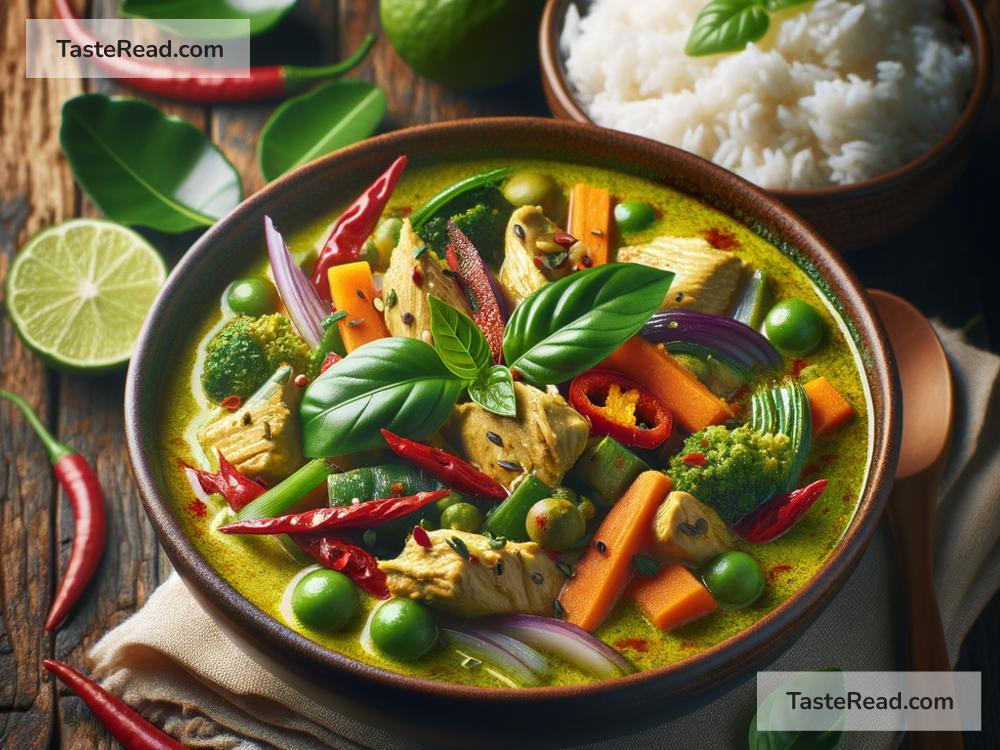Thai Green Curry: A Flavorful Journey Across Thailand
Thai green curry, or “kaeng khiao wan,” is one of the most famous dishes from Thailand. It’s known for its vibrant green color, creamy coconut base, and bold yet balanced flavors. This delicious curry is enjoyed not only in Thailand but also around the world. However, what many people don’t realize is that green curry has regional variations across Thailand. Each region adds its own unique touch to this iconic dish, making it a reflection of the diverse culinary traditions found within the country.
What Is Thai Green Curry?
Thai green curry is made with green curry paste, coconut milk, meat or seafood, vegetables, and fresh herbs. The green curry paste is the heart of the dish. It’s traditionally made from ingredients like green chilies, garlic, shallots, lemongrass, galangal (a root similar to ginger), coriander roots, kaffir lime peel, and shrimp paste. The paste is blended together to create a fragrant and spicy mixture.
To make the curry, the paste is cooked in coconut milk, which mellows the heat of the chilies and adds richness. Common proteins used in green curry include chicken, pork, beef, fish, or shrimp. Vegetables often include eggplant, bamboo shoots, zucchini, or green beans. Fresh basil leaves are added at the end for a burst of herbal flavor.
Green curry is typically served with steamed jasmine rice or rice noodles, depending on personal preference. It’s a dish that combines spicy, sweet, creamy, and aromatic flavors, making it incredibly satisfying.
Regional Variations Across Thailand
Thailand is divided into four main regions: Central, Northern, Northeastern (Isaan), and Southern. Each region has its own distinct culture, traditions, and flavors, which influence the way green curry is prepared.
Central Thailand
Green curry as we know it originated in Central Thailand. This is where it remains closest to the “standard” version recognized internationally. Central Thai green curry is balanced in flavor—rich, slightly sweet, mildly spicy, and creamy due to the generous use of coconut milk. It often includes chicken or fish, along with eggplants and bamboo shoots. Basil leaves and kaffir lime leaves are added for freshness.
In Central Thailand, the dish is typically enjoyed with steamed jasmine rice, which complements the curry’s creamy texture. Additionally, Central Thai curries are known for their vibrant green color, as fresh green chilies are used generously in the paste.
Northern Thailand
Northern Thailand has cooler weather and a preference for milder flavors compared to other regions. In this area, green curry tends to be less spicy and may have a thinner consistency with less coconut milk. People in the North sometimes replace coconut milk entirely with water or chicken stock.
Herbs like Thai coriander (pak chee) and wild ingredients may be used to enhance the flavor profile, keeping the dish focused on fresh, earthy flavors. Pork or beef is commonly used as the protein, and local vegetables like makua phuang (pea-sized eggplants) may be added. Green curry in Northern Thailand is often enjoyed with sticky rice instead of jasmine rice, which is a staple of the region.
Northeastern Thailand (Isaan)
The Northeastern region has a very distinct food culture, influenced by both Thailand and Laos. Isaan dishes are often spicy and sour, and green curry is no exception. While coconut milk is still used, it may be less creamy than the Central Thai version. The focus is on bold, sharp flavors.
Isaan green curry might feature local fish, dried shrimp, or even fermented fish sauce for extra depth. It’s common to add herbs like dill (known locally as “pak chi lao”), which is unique to this region. Sticky rice serves as the perfect accompaniment, allowing diners to scoop up the curry with their hands.
Southern Thailand
Southern Thai cuisine is known for its bold, spicy flavors and heavy use of coconut milk. Green curry in this region is no exception—it’s often richer and spicier than versions from other parts of the country. Southern cooks may add extra chilies to the curry paste, giving the dish a fiery kick.
Seafood is a popular choice for the protein in Southern green curry, including prawns, fish, or squid, as the region is located near the coast. Additionally, turmeric, which is widely used in Southern Thai cooking, may be added to the dish, giving it a slightly yellow-green hue. Southern green curry is usually paired with steamed rice, though rice noodles (known as “kanom jeen”) are also a common choice.
Why Is Green Curry So Special?
Thai green curry is more than just a delicious dish; it’s a reflection of Thailand’s rich culinary heritage. Its layers of flavor come from fresh ingredients and traditional techniques that have been passed down for generations. Regional variations show how Thai food adapts to local tastes, ingredients, and climate.
Whether you like your green curry mild or spicy, creamy or light, there’s something for everyone in this beloved dish. The next time you enjoy Thai green curry, take a moment to appreciate the care and creativity that go into making it—and consider exploring the regional versions for an even deeper understanding of Thai cuisine!
Conclusion
Thai green curry is one of Thailand’s most iconic dishes, celebrated for its rich flavors and versatility. While it originates from Central Thailand, each region adds its own spin, showcasing the diversity of Thai culinary traditions. So, whether you find yourself in Bangkok, Chiang Mai, or Phuket, don’t miss the chance to savor this tasty dish—each bite is a delicious journey through the heart of Thailand!


